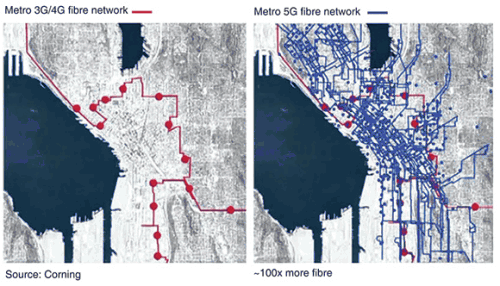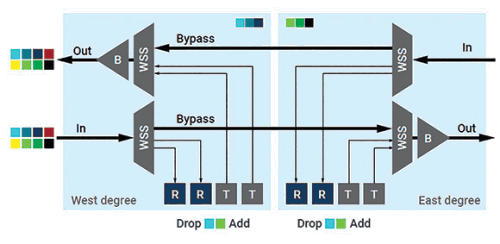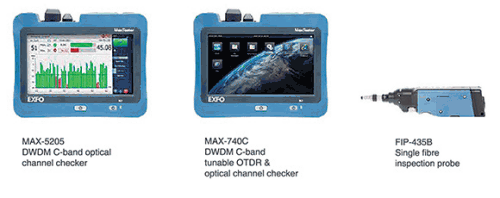
The fifth generation of mobile wireless communications, or 5G wireless, has been and continues to be the subject of a great deal of consumer marketing and popular interest.
5G promises to deliver mobile broadband data rates of more than 1 Gbps, lower end-to-end latency down to 1 ms and improve connectivity and coverage – ultimately providing enhanced end-user experience.
Carriers who were early adopters of 5G turned up about 30 5G NR Sub-6 (FR1)
networks internationally in the second half of 2019 and the early test reports regarding these end-customer benefits seem encouraging. With the introduction of mmWave (millimetre-wave) services (RF2) in the coming years, the leaps forward in raw performance and subscriber value will become more and more evident.

5G bandwidth and fibre densification
As might be obvious to network technologists, this massive performance increase in the worldwide wireless broadband network, which now serves more than 5 billion unique subscribers, requires much fatter pipes
between the cellular base stations and the Internet core. This includes the front-haul links between the remote radios and their digital baseband controller or servers, the backhaul links between the digital baseband compute servers and their C·RAN hubs and the metro scale 400G/800G Ethernet optical networks linking the regional Internet service providers and the massive commercial data centres
where all our favourite apps and shopping services are hosted. In fact, Corning has estimated the fibre densification ‘heavy lift’ required to support the worldwide carrier upgrade to 5G in metro areas at about two orders of magnitude.
While this demand for new fibre infrastructure will be met through a great deal of trenching and stringing of new cable, these operations are time consuming (due to permits and other regulatory constraints) and costly (high opex due to the high level of skills required and staffing overhead). Faced with these costs, network managers are looking closely at technology options that allow existing fibre routes to carry more data; this typically leads to familiar wavelength division multiplexing (WDM) methods.
Wavelength division multiplexing value proposition for 5G: what’s old is new
It is a basic principle of physical optics that different wavelengths or colours of light do not interfere in a uniform transmission media such as silica glass fibre.
Telecom WDM systems have been operational since the 1980s, but have never achieved the expected commercial success. But now semiconductor lasers and micro thermoelectric coolers make the transmission of tightly spaced (100 GHz or less) parallel wavelengths straightforward and inexpensive and the required multiplexers and demultiplexers can be used in high-volume photonic integrated circuits.
Equally importantly, 5G fibre densification has upset the ROI (return on investment) economics of large-scale WDM deployments, particularly in the context of emerging mmWave urban small-cell environments. Poor signal propagation and small cell sizes, combined with overbuilt brownfield site conditions, will make the increased use of existing fibre infrastructure economically attractive and scalable for even the largest worldwide telecom players moving into the new decade.
The new 400ZR coherent transceiver implementation agreement from OIF is a good illustration of cutting-edge optical component technology for WDM in 5G networks. 400ZR is a 400 Gbps Ethernet specification intended for both client-side and line-side interconnect over an 80 km minimum reach.
The emerging 400ZR+ concept specification extends reach to 500 km, far more than enough for 5G backhaul use cases, as well as OTN protocol support. 15 W maximum power dissipation 400ZR QSFP-DD and OSFP MSA form factor transceivers have been announced and sampled at the time of writing.
400ZR supports IP over DWDM, so these transceivers must support 100 and 75 GHz ITU-T G.694.1 grid laser wavelength tuning, along with 60 Gbaud, dual-polarisation (DP) 16QAM and C-FEC (hard-decision outer FEC/soft-decision inner FEC). They must also operate within a 26 dB OSNR link budget.
400ZR transceivers use cutting-edge 7 nm CMOS digital signal processor chips to perform polarisation mode dispersion equalisation, chromatic dispersion equalisation and other inter-symbol interference compensation. In 5G use cases, 400ZR will enable the high-bandwidth backhaul of sixteen 25 Gbps eCRPI streams on one wavelength.
The key point here is the presence today of high-volume, low-cost, thermal-drift-stable, low-power tuneable C-band (single-mode) semiconductor integrated lasers, as they will profoundly impact the economics of DWDM for 5G xhaul in the coming years.

WDM technology overview: CWDM, DWDM and HOADM basics
The operating principle for passive WDM is widely understood. WDM essentially virtualises total fibre bandwidth using parallel coloured light channels. Note that in 5G use cases, typically both the downstream and upstream paths use WDM, though the illustration in Figure 2 only shows unidirectional traffic. These optical components have insertion loss and reflective return loss that must be carefully budgeted.
Coarse WDM (ITU-T G.694.2) defines 18 channels between 1271 nm and 1611 nm using 20 nm spacings. While the relatively wide channel spacing allows the use of non-temperature-stabilised lasers, CWDM channels are spaced such that Erbium-doped fibre amplifiers cannot be used and this limits rate and reach to about 2,5 Gbps over about a 60 km distance.
Dense WDM (ITU-T G.694.1) can use both the C-band (1530 nm to 1565 nm) and the L-band (1565 nm to 1625 nm) with 100/50/25/12,5 GHz spacings yielding up to 160 lambda channels. Typically and as expected in 5G use cases, the C-band is used with either a 100 GHz or 50 GHz spacing to yield roughly 40 channels or 80 channels respectively. Both EDFA and Raman amplification can be used with DWDM, eliminating practical limits to both rate
and reach, which promises an exciting future.
Reconfigurable optical add-drop multiplexers (ROADMs) extend passive WDM systems with wavelength-selectable switching to enable remote (and automated) lambda reconfiguration and reassignment. While ROADMs have typically been used in metro Ethernet ring networks, 5G fibre densification will likely lead to their increased use in telecom network edge applications.
ROADMs can include active optical components such as integrated fibre amplifiers and dispersion compensation modules to extend data rates and link reach. Gridless ROADMs support ‘flexgrid’ channel mapping, a critical spectral efficiency approach that is synergistic with modern high-bandwidth coherent transceivers, such as 400ZR plug-in transceiver modules.

DWDM cost dynamics: equipment and deployments
The 5G equipment industry segment is benefiting from advances in integrated phonic components, which leverage the same photolithographic manufacturing technology as integrated CMOS electronic circuits, yielding dramatic reductions in unit cost.
Service providers and/or enterprise carriers thus have a very different cost structure equation for outside-plant 5G fibre densification, where adopting dense wavelength division multiplexing (DWDM) on existing fronthaul and backhaul links can now be considerably more compelling than pulling more single-mode ribbon cable. This is all the more true since ‘time is money’ and the competitive Wall Street pressure to show progress to impatient stakeholders with 5G deployments is intense.
For example, applying DWDM and ROADM equipment to existing single lambda point-to-point links eliminates the permit, right-of-way costs and indeterminate delays associated with new trenching and stringing activities. Furthermore, existing single-mode fibre runs are typically known to be good from a continuity and optical insertion loss or return loss perspective, so DWDM wavelength service turn-up can be rapid.
DWDM use cases: dark fibre and live fibre
Network operators can apply DWDM to either previously unused or newly acquired dark fibres, or on existing live fibres currently carrying single lambda traffic. The principal difference is that in many cases, dark fibre is essentially uncharacterised or uncertified and must generally be tested for Tier-1 optical performance certification as a key operational first step.
When dealing with dark fibre, technicians must conduct continuity assurance tests – making certain that light (whether visible red from a fault locator or invisible infrared) passes from the correct near-end transmitter to the correct far-end receiver. This test can be combined with a Tier-1 bidirectional loss test using a calibrated test set – a light source at one end and a power meter at the other end.
Tier-1 insertion loss testing ensures that no egregious cable macrobends, bad splices or contaminated connector endfaces exist across the link span, but does not generally provide the technician directly with any actionable feedback. Shooting a Tier-2 OTDR link map diagnostic (or better yet, EXFO’s iOLM intelligent Optical Link Mapper) will debug any continuity events that the optical loss test set exposes and give accurate locations (in metres or feet) for each of the suspicious events along the link, to allow the technical team to quickly perform the necessary repairs. Other modern test and measurement (T&M) tools, such as EXFO’s Optical Explorer (OX1) optical multimeter, can quickly measure the link length and link optical reflection loss and qualitatively assess link quality based on machine learning heuristics.
After the DWDM and ROADM equipment has been installed, users can verify the correct lambda routing using a DWDM OTDR, which sequentially generates the ITU-T G.694.1 channel wavelengths using a temperature-stable tunable laser. The use of a DWDM channel checker with an appropriate DWDM light source can also validate lambda routing and acceptable end to-end channel loss compliance. Note that non-DWDM specific OTDRs cannot test through ROADM network elements.
One of the biggest operational challenges for CO and OSP technicians is detecting and resolving physical fibre mislabelling. There are generally two, three or more fibre distribution panels (FDP) in real-world fronthaul and backhaul optical circuits. Obviously, the correct physical fibres must be interconnected and accurately labelled at each FDP and labelling mistakes or human errors commonly occur. Live traffic fibre identifiers, visual fault locators, light sources and power meters and link mapping OTDRs are all tools that assist in this important task.

EXFO field tools for 5G DWDM/CWDM construction, service turn-up and maintenance
There are at least three phases for all new network upgrades: construction, service turn-up and maintenance. EXFO offers best-in-class field-oriented test and measurement tools to support each of these.
DWDM optical-physical-layer testing is generally done bidirectionally and like single-lambda transmission scenarios, is categorised into Tier-1 (light source and power meter) or Tier-2 (OTDR/iOLM) testing. EXFO recommends Tier-1 test procedures for construction validation, combined Tier-1 and Tier-2 test procedures for service turn-up and Tier-2 test procedures for maintenance operations. In all cases, it is essential to inspect and completely clean all connector endfaces to ensure the highest network quality, as contaminated endfaces are responsible for the majority of optical network failures.
For Tier-1 construction validation and service turn-up, EXFO recommends using a DWDM tuneable laser source on one end of the link and a DWDM optical channel checker on the other end of the link. The method requires two technicians to work together, sequencing through the required DWDM channels at the near end and ensuring the light level measured at the far end exceeds the required power threshold (which depends on the link length and the available optical link budget). This method is much like Tier-1 single-lambda OLTS certification testing.
For Tier-2 service turn-up and maintenance, EXFO recommends a DWDM tuneable OTDR with intelligent optical link mapping for a single-ended test procedure. A single technician can verify link continuity, link integrity and optical return loss on a per-DWDM-lambda basis. If any faults are found, the OTDR link mapper will accurately identify the location of the event for resolution. One clear benefit of this method of procedure is the ability to conduct in-service tests on a live DWDM link without disturbing adjacent revenue-generating wavelength services.
The EXFO products intended for DWDM applications in 5G networks include:
EXFO MAX-5205 DWDM C-band optical channel checker
• ±1 dB absolute power uncertainty per channel.
• Support for 100 GHz ITU channel spacing.
• Ultrafast <0,5 second full C-band test time.
• Low-power sensitivity (down to -48 dBm) to test through monitor ports/taps.
• Bar graph and table display with programmable green/red (pass/fail) thresholds.
EXFO MAX-740C optical wave expert DWDM tuneable OTDR/channel checker
• Integrated DWDM channel checker and OTDR on a single port.
• Integrated channel power level diagnostics (iOCC).
• iOLM-ready with one-touch multiple acquisition and clear MUX/DEMUX element characterisation.
• Continuity and end-to-end power loss validation through MUX, DEMUX and ROADM equipment.
• In-service test using customer’s wavelength port without revenue downtime.
• DWDM OTDRs are also available in the compact FTB-1v2 dual-carrier platform.
EXFO FIP-435B wireless fibre inspection probe
• Adaptor tips for all connector types, including LC, CS and SN.
• IEC compliant pass/fail endface auto-analysis.
• ConnectorMax2 smart device mobile app (Android and iOS).
• All-day battery life.
• Upgradable to multi-fibre inspection (MPO/MTP).
Conclusion and resources
The deployment of 5G services worldwide is driving a massive increase in fibre densification for the required fronthaul and backhaul links interconnecting radio base stations and web-scale core packet networks. Dense WDM is a familiar existing optical technology that is now ideally and serendipitously suited to meet the technical demands of 5G fibre densification.
New industry standards and related cutting-edge optical components and transceiver modules have utterly reset the scale-out economics of DWDM adoption for telecom edge networks. EXFO offers 5G Internet service providers unique, comprehensive test and measurement equipment to make DWDM upgrades to dark and live 5G fibre links easy, super-fast and cost-effective.
| Tel: | +27 12 349 1341 |
| Email: | [email protected], [email protected] |
| www: | www.lambdatest.co.za |
| Articles: | More information and articles about Lambda Test |

© Technews Publishing (Pty) Ltd | All Rights Reserved